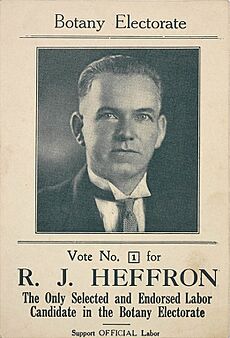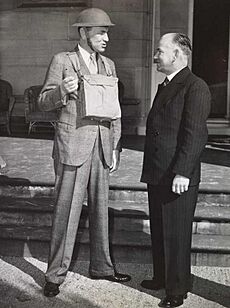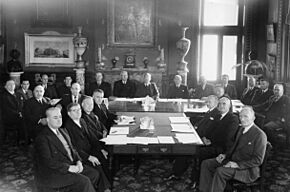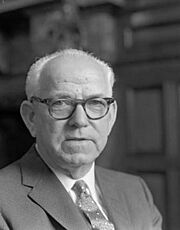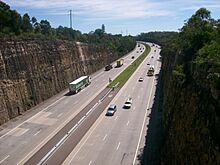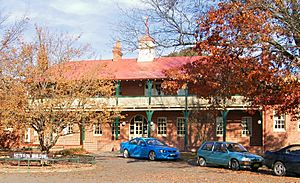Bob Heffron facts for kids
Quick facts for kids
Bob Heffron
|
|
|---|---|
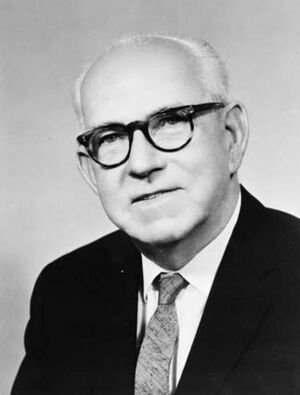
Heffron as Premier in 1963
|
|
| 30th Premier of New South Wales Election: 1962 |
|
| In office 23 October 1959 – 30 April 1964 |
|
| Monarch | Elizabeth II |
| Governor | Sir Eric Woodward |
| Deputy | Jack Renshaw |
| Preceded by | Joseph Cahill |
| Succeeded by | Jack Renshaw |
| Minister for Education | |
| In office 8 June 1944 – 31 May 1960 |
|
| Premier | William McKell James McGirr Joseph Cahill Himself |
| Preceded by | Clive Evatt |
| Succeeded by | Ernest Wetherell |
| 4th Deputy Premier of New South Wales | |
| In office 23 February 1953 – 28 October 1959 |
|
| Premier | Joseph Cahill |
| Preceded by | Joseph Cahill |
| Succeeded by | Jack Renshaw |
| Member of the New South Wales Parliament for Botany |
|
| In office 25 October 1930 – 22 May 1950 |
|
| Preceded by | Thomas Mutch |
| Succeeded by | District abolished |
| Member of the New South Wales Parliament for Maroubra |
|
| In office 17 June 1950 – 23 January 1968 |
|
| Preceded by | New district |
| Succeeded by | Bill Haigh |
| Personal details | |
| Born |
Robert James Heffron
10 September 1890 Thames, Colony of New Zealand |
| Died | 27 July 1978 (aged 87) Kirribilli, New South Wales, Australia |
| Resting place | Eastern Suburbs Memorial Park |
| Political party | New Zealand Socialist Party Victorian Socialist Party Industrial Labor Party Australian Labor Party (New South Wales Branch) |
| Spouse | Jessie Bjornstad (m.1917–1977) |
| Children | Maylean Jessie Cordia OAM (1919–2006) June Ellen Healy (1923-2008) |
Robert James Heffron (born 10 September 1890 – died 27 July 1978), also known as Bob Heffron, was an important politician in New South Wales, Australia. He was a union organiser and later became the Premier of New South Wales for the Labor Party from 1959 to 1964.
Born in New Zealand, Heffron was involved in different socialist and worker movements there. He then moved to Australia and joined the Australian Labor Party. He was a strong supporter of unions and was even jailed once for encouraging a strike. In 1930, he was elected to the Parliament of New South Wales for the area of Botany.
Heffron had disagreements with the Labor Party leader, Jack Lang, and was even kicked out of the party for a while. He formed his own group called the Industrial Labor Party. This group became successful, and he was allowed back into the Labor Party. He played a big part in the party after Lang left, and the Labor Party won the election in 1941.
Heffron served as a minister in several governments, including as Minister for Education from 1944 to 1960. He also served as Deputy Premier. As Education Minister, he made big changes, like the "Wyndham Report" and the Public Education Act of 1961. He also helped build many new public schools and started new universities, like the University of New South Wales.
When he became Premier in 1959, he tried to get rid of the New South Wales Legislative Council (an upper house of parliament) through a public vote, but it failed. He was a member of the New South Wales Parliament for 37 years before he retired in 1968.
Contents
Early Life and Beginnings
Bob Heffron was born in Thames, New Zealand, on 10 September 1890. He was the fifth child of Irish parents. His father, Michael Heffron, was a blacksmith. Bob left school at 15 to work in a gold-treating plant. He also studied metallurgy (the science of metals) at the Thames School of Mines.
When he was 19, he traveled to California and then to the Yukon in Canada, hoping to find gold. When that didn't work out, he returned to New Zealand in 1912.
In 1912, Heffron joined the New Zealand Socialist Party. He became a union organiser for miners and was involved in the Waihi miners' strike. This strike was important for the worker's rights movement in New Zealand. He also studied law part-time at Auckland University College.
During the First World War, Heffron tried to join the military but was rejected because of heart problems. On 29 December 1917, he married Jessie Bjornstad. They had two daughters, Maylean Jessie and June.
In 1921, the Heffrons moved to Melbourne, Australia. Bob became an organiser for a clothing union and joined the Victorian Socialist Party. Later that year, he moved to Sydney and became the secretary of a marine stewards' union. He worked in this role for ten years and was very active in maritime (sea-related) unions.
In 1924, Heffron and six other union leaders were arrested. They were accused of planning a strike because they told workers not to work on a ship that was considered unsafe. They were refused bail, meaning they had to stay in jail before their trial. However, they were found not guilty and released in July 1924. Heffron later joined the Labor Party.
Starting in Politics
Heffron first ran for parliament in 1927 for the area of Botany. He lost that election but won in 1930, becoming a member of the New South Wales Parliament. He held the seat of Botany until 1950.
Even though his support for party leader Jack Lang helped him start his political career, Heffron became unhappy with Lang's leadership style. Lang was very controlling, especially during the Great Depression.
After the Labor Party lost elections in 1932 and 1935, Heffron joined a group of politicians who wanted to remove Lang as leader. However, Lang still had a lot of control over the party.
Forming the Industrial Labor Party
In 1936, Lang expelled Heffron and other leaders from the Labor Party. As a result, Heffron and his colleagues formed their own party, called the Industrial Labor Party (ILP). This new party did surprisingly well against Lang's Labor Party.
Because of their success, the federal Labor Party pressured the New South Wales Labor Party to let Heffron and his group rejoin. This happened in August 1939. Heffron then worked with William McKell to remove Lang as leader. McKell became the new leader of the party.
Serving as a Minister
National Emergency Services
When the Labor Party won the election in May 1941, Heffron became the Minister for National Emergency Services. His job was to prepare New South Wales for emergencies, especially during the Second World War. This included setting up civil defence and air-raid precautions. This became very important after Japan entered the war and attacked places like Darwin and Sydney in 1942.
Heffron believed people needed to be ready. He said, "Many people have the idea that what is happening in other countries cannot happen here." He also disagreed with the federal government about "brownouts" (reducing street lights) in Sydney. He thought they were unnecessary and that a full "blackout" (turning off all lights) with short notice would be better.
Minister for Education
In June 1944, Heffron became the Minister for Education. In 1946, he wrote a plan for education in New South Wales called Tomorrow is Theirs. During the time of economic growth after the war, Heffron oversaw a huge expansion of public schools in NSW. The number of students doubled.
In 1952, he asked Harold Wyndham to lead a committee to review the high school system in New South Wales. The committee's report, known as "The Wyndham Report," was given to Heffron in 1957. This led to the Public Education Act of 1961, which changed high school to six years. It also introduced major statewide exams at the end of Year 10 (School Certificate) and Year 12 (Higher School Certificate).
Heffron also wanted to expand higher education. In 1946, he suggested creating a new university focused on technology. This led to the establishment of the "New South Wales University of Technology," which is now the University of New South Wales. This was the first time a second university was created in any Australian state. Heffron strongly supported this new university.
Heffron also helped establish other universities. He supported the creation of teachers' colleges across the state to train more teachers. He also helped establish the University of Newcastle and the University of New England. He believed in making university education available to more people, not just a few.
In 1950, his old electoral area of Botany was changed, and he was elected to represent Maroubra. He held this seat until he retired in 1968.
Deputy Premier and Leadership
Heffron was seen as a strong and capable minister. He had a chance to become Premier in 1946 when William McKell decided to resign, but he lost by two votes.
In 1952, when Premier Joseph Cahill resigned, Heffron again put himself forward. He realized he didn't have enough votes to win against Cahill. So, he made a deal with Cahill: Heffron would give his votes to Cahill to become Premier, and in return, Cahill would support Heffron to become Deputy Premier. This worked, and Cahill became Premier, and Heffron became Deputy Premier.
As Deputy Premier, Heffron took over when Cahill was away or unwell. He even welcomed the Japanese Prime Minister to Australia in 1957. When Premier Cahill died suddenly in October 1959, the 68-year-old Heffron was chosen to succeed him without anyone running against him.
Premier of New South Wales
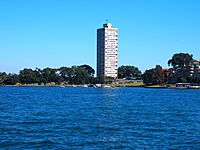
Bob Heffron became Premier of New South Wales on 23 October 1959. His time as Premier saw some challenges within the Labor Party. Many of his ministers had been in government since 1941, and some felt the government was getting old and tired. Heffron often let his Deputy, Jack Renshaw, do most of the talking in parliament.
Despite this, his government continued to make important changes. In 1960, Heffron officially opened the Warragamba Dam, which became the main water supply for Sydney. He said, "We have come a long way from the Tank Stream, Sydney's first water supply."
In 1961, his government introduced a new law called the Conveyancing (Strata Titles) Act 1961. This was a big step forward for apartment buildings. It allowed people to own individual units in a building, making it easier to buy and sell apartments. This was the first system of its kind in the world.
Appointing a Chief Justice
In 1960, Heffron appointed his old friend H. V. Evatt to be the Chief Justice of New South Wales, the top judge in the state. This decision was debated by some, but Heffron stood by his choice.
Trying to Abolish the Legislative Council
When Heffron became Premier, he decided to try and get rid of the Legislative Council of New South Wales. This was a long-standing goal of the Labor Party. Heffron believed the council was old-fashioned and stopped the elected government from doing its job. He announced that there would be a public vote (a referendum) on this issue in 1961.
However, Heffron faced a lot of opposition, not just from other political parties but also from some members within his own Labor Party. When the bill to abolish the council came before the Legislative Council, they sent it back. This caused a deadlock.
Heffron pushed for the referendum, which was held on 29 April 1961. He urged people to vote "Yes" to "get rid of a parliamentary anachronism" (something old-fashioned that doesn't fit modern times). However, the opposition parties ran a strong campaign against it, warning about a single-house parliament.
The referendum failed, with 57.5% of people voting against abolishing the council. This was the first time the NSW Labor Party had lost a statewide vote in many years, and it was seen as a sign that their long time in power might be ending.
Second Term as Premier
In the 1962 election, Heffron's Labor Party actually gained more seats. He promised things like creating a Department of Industrial Development to help with jobs, free school travel, and starting the construction of the Sydney–Newcastle Freeway as a toll-road.
Another issue during his second term was funding for schools. In 1962, there was a discussion about providing government help to Catholic schools. Heffron allowed some state support for school laboratories and an allowance for students based on their family's income. However, the federal Labor Party disagreed, and these plans were eventually dropped.
On 30 April 1964, Heffron, who was 73 years old and had been in politics for many decades, resigned as Premier. He said it was his own decision, made a year earlier. His Deputy, Jack Renshaw, took over as Premier. For his long service, Queen Elizabeth II allowed him to keep the title "The Honourable".
Later Life
After resigning as Premier, Heffron remained a Member of Parliament for Maroubra. He was re-elected in 1965, even though his Labor Party lost power for the first time in 25 years. He stayed in parliament until he retired in January 1968, after 37 years.
In his farewell speech, Heffron said he was happy he went into politics. He joked that if someone had told him he would become Premier, he would have thought they were crazy. He said he always tried his best.
Heffron passed away on 27 July 1978, at the age of 87. He was given a State funeral in Sydney, attended by many important people, including the Governor and several Premiers. He was buried at the Eastern Suburbs Crematorium.
Premier Neville Wran spoke about Heffron's achievements, especially as Education Minister. He said Heffron could be called the "father of the modern education system in New South Wales" because of his work to expand schools and ensure equal opportunities for all students.
Honours and Legacy
In 1947, Heffron was made an Honorary Fellow by the Royal Australian Historical Society. He also received honorary degrees from the University of Sydney in 1952 and the New South Wales University of Technology in 1955. These degrees recognized his dedication to education and his role in establishing the new university.
In 1956, a portrait of Heffron was painted by Henry Hanke. In 1962, the University of New South Wales named its newest building the "Robert Heffron Building" in his honour. He also received an honorary degree from the University of New England in 1956.
Heffron was a member of the board of directors for the Prince Henry Hospital in Little Bay for 17 years. In 1961, a building at the hospital was named "Heffron House" to recognize his service.
Many places are named after him:
- In 1962, South Sydney Boys' High School named its library the "R. J. Heffron Library."
- Randwick Boys High School and East Hills Boys High School also named their libraries and halls after him.
- In 1966, a community hall in Darlinghurst, Sydney, was named "Heffron Hall."
- In 1973, a new state electoral area was named Heffron.
- The Faculty of Education building at Charles Sturt University in Bathurst is named after him.
- Heffron Park and Heffron Road in Maroubra are named after him, as is Heffron Road in Lalor Park.
His daughter, Maylean, was awarded the Medal of the Order of Australia in 2005 for her work to preserve the history of the Prince Henry Hospital.
|


